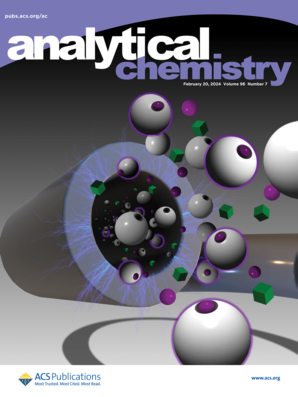Intelligent Screening of Functional Small Molecules for Targeting Metal-Induced Protein Aggregation
IF 6.7
1区 化学
Q1 CHEMISTRY, ANALYTICAL
引用次数: 0
Abstract
Screening small-molecule drugs to suppress protein aggregation and the production of reactive oxygen species (ROS) is one of the primary directions for drug development in neurodegenerative diseases (NDs). However, current methods often have difficulty in striking a balance between accuracy and simplicity. In this work, we constructed active peptide interfaces to intelligently screen potential drugs for metal-induced protein aggregation with a logic network. Taking β-amyloid peptide (Aβ), which is closely related to Alzheimer’s disease (AD), as an example, we covalently connected Aβ onto the gold electrode surface and characterized the aggregation state of Aβ induced by copper ions (Cu(II)) through electrochemical impedance spectroscopy (EIS). The formed Aβ-Cu(II) complex interfaces were also used to study the catalytic production of ROS and the ameliorative effect of potential drugs on oxidative stress by the ultraviolet (UV) spectrum of ascorbic acid (AA). By constructing a comparator logic network using EIS and UV signals, the potential small molecules targeting Aβ-Cu(II) aggregations could be classified into 4 different types of effects. Transmission electron microscopy (TEM), cytotoxicity, and ROS assays were used to verify the reliability of the classification. The corresponding results of using α-synuclein (α-Syn) instead of Aβ indicated that this intelligent screening platform might provide a general route for potential NDs’ drug screening.

靶向金属诱导蛋白质聚集的功能小分子智能筛选
筛选抑制蛋白质聚集和活性氧(ROS)产生的小分子药物是神经退行性疾病(NDs)药物开发的主要方向之一。然而,目前的方法往往难以在准确性和简单性之间取得平衡。在这项工作中,我们构建了活性肽界面,通过逻辑网络智能筛选金属诱导蛋白质聚集的潜在药物。以与阿尔茨海默病(AD)密切相关的β-淀粉样肽(Aβ)为例,将Aβ共价连接到金电极表面,并通过电化学阻抗谱(EIS)表征了铜离子(Cu(II))诱导的Aβ聚集状态。通过抗坏血酸(AA)的紫外(UV)光谱研究了所形成的a - β- cu (II)络合物界面对活性氧的催化生成和潜在药物对氧化应激的改善作用。利用EIS和UV信号构建比较逻辑网络,将靶向a β- cu (II)聚集的潜在小分子分为4种不同类型的效应。透射电镜(TEM)、细胞毒性和活性氧测定验证了分类的可靠性。用α-突触核蛋白(α-Syn)代替α- β的相应结果表明,该智能筛选平台可能为潜在新药的药物筛选提供一条通用途径。
本文章由计算机程序翻译,如有差异,请以英文原文为准。
求助全文
约1分钟内获得全文
求助全文
来源期刊

Analytical Chemistry
化学-分析化学
CiteScore
12.10
自引率
12.20%
发文量
1949
审稿时长
1.4 months
期刊介绍:
Analytical Chemistry, a peer-reviewed research journal, focuses on disseminating new and original knowledge across all branches of analytical chemistry. Fundamental articles may explore general principles of chemical measurement science and need not directly address existing or potential analytical methodology. They can be entirely theoretical or report experimental results. Contributions may cover various phases of analytical operations, including sampling, bioanalysis, electrochemistry, mass spectrometry, microscale and nanoscale systems, environmental analysis, separations, spectroscopy, chemical reactions and selectivity, instrumentation, imaging, surface analysis, and data processing. Papers discussing known analytical methods should present a significant, original application of the method, a notable improvement, or results on an important analyte.
 求助内容:
求助内容: 应助结果提醒方式:
应助结果提醒方式:


